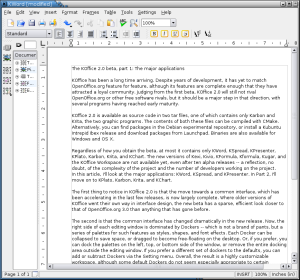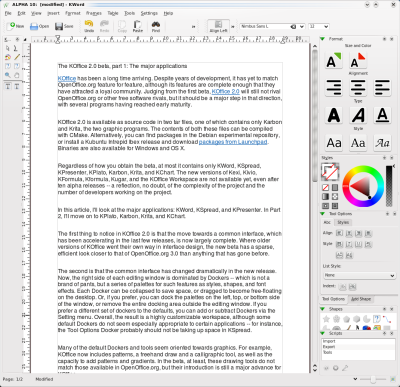Author: Bruce Byfield
KOffice has been trailing the office application leaders for a long time. Despite years of development, it has yet to match OpenOffice.org feature for feature, although its features are complete enough that they have attracted a loyal community. Judging from the first beta, KOffice 2.0 will still not rival OpenOffice.org or other free software rivals, but it should be a major step in that direction.
KOffice 2.0 is available as source code in two tar files, one of which contains only Karbon and Krita, the two graphic programs. Alternatively, you can find packages in the Debian experimental repository, or install a Kubuntu Intrepid Ibex beta release and download packages from Launchpad. Binaries are also available for Windows and Mac OS X.
Regardless of how you obtain the beta, at most it contains only KWord, KSpread, KPresenter, KPlato, Karbon, Krita, and KChart. The new versions of Kexi, Kivio, KFormula, Kugar, and the KOffice Workspace are not available yet, even after 10 alpha releases — a reflection, no doubt, of the complexity of the project.
In this article, I’ll look at the major applications: KWord, KSpread, and KPresenter. In Part 2, I’ll move on to the other four.
The first thing to notice in KOffice 2.0 is that the move toward a common interface, which has been accelerating in the last few releases, is now largely complete. Where in older versions, few interface features were common to every application, the new beta has a unified look, a spare, efficient one that’s closer to that of OpenOffice.org 3.0 than anything that has gone before.
The second is that the common interface has changed dramatically in the new release. Now, the right side of each editing window is dominated by Dockers — not a brand of pants, but a series of palettes for such features as styles, shapes, and font effects. Each Docker can be collapsed to save space, or dragged to become free-floating on the desktop. Or, if you prefer, you can dock the palettes on the left, top, or bottom side of the window, or remove the entire docking area outside the editing window. If you prefer a different set of Dockers to the defaults, you can add or subtract Dockers via the Setting menu. Overall, the result is a highly customizable workspace, although some default Dockers do not seem especially appropriate to certain applications — for instance, the Tool Options Docker probably should not be taking up space in KSpread.
Many of the default Dockers and tools seem oriented toward graphics. For example, KOffice now includes a Docker for various patterns, a freehand draw and a separate calligraphic tool, as well as the capacity to add patterns and gradients. In the beta, at least, the selection of drawing tools is not as well-rounded as those available in OpenOffice.org, but their introduction is still a major advance for KOffice.
Another common change is the introduction of scripts — that is, macros or extensions, if you are used to the naming conventions of other office suites. Although they do not seem to enabled in the beta, you can view some of the items in the scripts from the Tools menu. Interestingly enough, they include OpenOffice.org Uno, that office suite’s scripting and extension subsystem, which suggests that compatibility with OpenOffice.org extensions will be part of the final release. It may well be that scripts will be the feature that makes KOffice fully featured at last.
The KWord text processor
As a text processor, KWord is noted for its use of frames, which allow the creation of complex layouts quickly. In previous versions, frames were emphasized by icons for their creation on the left side of the editing window, as well as a tree view of the document’s structure. In the version 2.0 beta, frame controls have been de-emphasized by confining them to a menu. Since layout that requires frames is more advanced usage than most people are likely to want, this change seems appropriate.
However, if you are a user of styles, you may find that the default Dockers make the sloppy habit of manual formatting too easy by making the tools you need always easily available. True, styles are included among the Dockers, but far more Dockers encourage manual formatting.
Additions to the latest version of KWord include such features as file encryption (available from File -> Documentation Information) and a variety of graphical bullets in style definitions that make OpenOffice.org’s selection of bullets look tired and trite.
For the most part, the KWord beta offers little that is new for the average text document. In fact, it lacks many of the features of version 1.6.3 — particularly support for tables — although most of those, presumably, will be in the final version. However, more than any other application in KOffice, KWord benefits from the new drawing tools and Dockers, which strengthen its desktop publishing abilities, especially for projects that will be printed immediately and not heavily revised over their lifespans.
The KSpread spreadsheet
KOffice’s spreadsheet has probably undergone the greatest number of additions of any of the office suite’s applications. By my count, KSpread has added more than 170 new functions since version 1.6.3, an increase of nearly 50%. Many are intended to make KSpread more compatible with Microsoft Excel and OpenOffice.org Calc.
Almost as importantly, the latest version of KSpread gains some much needed sorting and filtering capacity, strengthening the ability to manipulate lists — one of the most basic uses of spreadsheets. In addition, KSpread gains some new formula utilities, including Validity, a handy graphical tool for naming cell ranges, and a Function Optimizer that might be described as a form of Goal Seek. A few standard spreadsheet functions, such as pivot tables or datapilots and grouping and outline, are still absent, but KSpread is shaping up to be the KOffice application that comes closest to matching rival programs feature for feature.
The KPresenter slide show program
In the first beta, KPresenter 2.0 is still rough, with many of the items in the Insert, Format, and Slide Show menus of version 1.6.3 still absent. That makes it almost impossible to assess.
However, what can be said is that KPresenter has undergone some interface changes, with a note view replacing the note pane in the editing window, and the Text menu eliminated. It also has added support for custom animation, and a presenter view that gives anyone delivering a presentation a console on their own monitor, like the Sun Presenter Console extension for OpenOffice.org. These additions are welcome, so far as they go, but what else is scheduled for KPresenter — in particular, the important question of whether the new version will support sound, and how — is impossible to say with this release.
Conclusion
For those who would like to see more KOffice applications among the best of free software programs, the enhancement of KSpread is encouraging. But, unfortunately, the same cannot be said of KWord and KPresenter. Both these programs have lived on potential for so many years that I, for one, have just about despaired of them ever living up to their full promise.
True, KWord, KSpread, and KPresenter all show marked improvements in the version 2.0 beta, and the common interface fits well with the KDE 4.x desktop. The changes are generally promising, not least because they have been accomplished without any noticeable loss of speed compared to earlier versions.
All the same, the release has so many features missing and suffers from so much instability that it only just qualifies as a beta. For this reason, any conclusions must be tentative. For now, it appears that, except for KSpread, the major applications, have improved, but not advanced as far as many users might hope — but that might change before the final release.
Categories:
- Reviews
- Office Software





